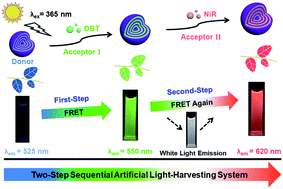A highly efficient artificial light-harvesting system with two-step sequential energy transfer based on supramolecular self-assembly†
Abstract
A highly efficient artificial light-harvesting system (ALHS) in the aqueous phase with a two-step sequential energy transfer process has been successfully constructed based on the host–guest interaction between a water-soluble pillar[5]arene (WP5) and a bola-type bis(4-phenyl)acrylonitrile derivative (BPT), as well as two different hydrophobic fluorescent dyes (4,7-bis(thien-2-yl)-2,1,3-benzothiadiazole (DBT) and Nile Red (NiR)). The fabricated ALHS shows an ultrahigh antenna effect (47.8 for the first step and 20.1 for the second step) with a high donor/acceptor ratio of 350 : 1. It is noted that the obtained WP5⊃BPT supramolecular nanoparticles possess an enhanced aggregation-induced emission (AIE) effect and can function as an ideal donor to realize the first-step of energy transfer from the WP5⊃BPT assembly to DBT. Moreover, inspired by the sequential energy transfer in nature, NiR was carefully selected as the second acceptor to fabricate an efficient two-step sequential light-harvesting system based on the WP5⊃BPT–DBT–NiR assembly, which exhibits a high FRET efficiency of 60.9% and 89.4% for the two-step sequential energy transfer process, respectively. Notably, the emission color changed from light blue to bright green and then to bright red during this process, and thus by tuning the molar ratio of DBT and NiR, a bright white light emission can be achieved with a high fluorescence quantum yield of 23.5%, which showed a strong ability for white fluorescence emission and promising applications in visible-light photocatalysis.



 Please wait while we load your content...
Please wait while we load your content...